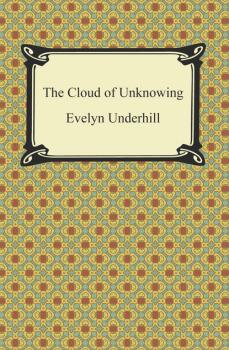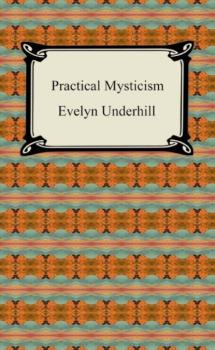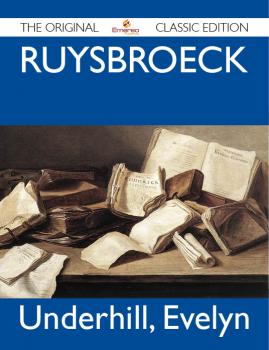ТОП просматриваемых книг сайта:
Evelyn Underhill
Список книг автора Evelyn UnderhillАннотация
Evelyn Underhill blieb trotz ihrer wachsenden Hinneigung zum Katholizismus lebenslang ihrer anglikanischer Konfession und Kirchenmitgliedschaft treu. In ihrer Forschung zur Mystik ging sie aber mit gleichem Interesse auch ostkirchlich-orthodoxen, protestantischen wie auch außerkirchlichen Formen der Mystik nach. Sie behandelt dort Geschichte, Systematik und Praxis der Mystik.
Аннотация
"The Life of the Spirit and the Life of To-day" by Evelyn Underhill. Published by Good Press. Good Press publishes a wide range of titles that encompasses every genre. From well-known classics & literary fiction and non-fiction to forgotten−or yet undiscovered gems−of world literature, we issue the books that need to be read. Each Good Press edition has been meticulously edited and formatted to boost readability for all e-readers and devices. Our goal is to produce eBooks that are user-friendly and accessible to everyone in a high-quality digital format.
Аннотация
First published in 1911, “Mysticism” is the seminal work on the subject by noted English Christian mystic and author Evelyn Underhill. The book is divided into two parts which examine both the history and meaning of mysticism and how it can be a part of one’s daily life and spiritual practice. In the first part, “The Mystic Fact”, Underhill explores the theological, psychological, and philosophical underpinnings of mysticism from a historical perspective. Underhill rejected the association often made between mysticism and magic or the occult and sought to clear up the many misunderstandings and confusions surrounding the topic. She contended that mysticism should be viewed as a legitimate psychological phenomenon and an important part of spirituality and spiritual leadership. In the second part, “The Mystic Way”, Underhill examines the application of mysticism in one’s life as a means for spiritual growth. She argues that incorporating mystical practices can help one achieve a more loving and creative life. Underhill’s “Mysticism” remains a widely read and hugely influential work on the historical importance of this little understood practice. It is both a fantastic introduction to the search for spirituality through mysticism and an almost encyclopedic examination of the subject.
Аннотация
Mysticism is usually thought of as an intense state involving personal unification with the Divine or Ultimate Reality. By its very nature, it is an ineffable experience, impossible to put into words. It is not impossible, however, to study the phenomenon, with an eye toward understanding not only its nature and manifestations, but its relationship to spirituality in general. This book is such a study. Widely considered the best book on mysticism for the general reader, this classic volume assembles a broad range of information scattered among monographs and textbooks in many languages.The work of a noted British authority on mysticism, it is divided into two parts: the first provides an introduction to the general subject of mysticism and its relation to metaphysics, psychology, theology, magic, and symbolism. The second and longer part contains a detailed study of the nature and development of spiritual or mystical consciousness, including such topics as the awakening of the self, the purification of the self, voices and visions, introversion, ecstasy and rapture, the dark night of the soul, and the unitive life. An interesting appendix provides a historical sketch of European mysticism from the beginning of the Christian era to the death of Blake.Richly documented with material drawn from such great mystics as St. Teresa, Meister Eckhart, St. John of the Cross, and William Blake, this remarkable study will be of immense interest to students, psychologists, theologians — anyone interested in this extremely personal and powerful form of spiritual life.
Аннотация
Evelyn Underhill (1875-1941) was a renowned Anglo-Catholic poet and novelist whose works on mysticism were some of the most widely read in the early twentieth century. She and her husband, Hubert Stuart Moore, had no children, but travelled extensively throughout Europe where Underhill pursued her interests in art and Catholicism. As a product of the Edwardian era, Underhill was concerned with exploring the physic, the occult, the mystical, the scientific, and the spiritual in her works. In her later years, she became a lecturer and spiritual leader in the Anglican Church, and proponent of the power of contemplative prayer. In 1922 Underhill edited an anonymous work of Christian mysticism called «The Cloud of Unknowing». The work was written in the late 14th Century in Middle English, and is a treatise about seeking a pure entity of God through contemplation, not through knowledge and intellect. This version is often considered the best translation of the work to modern English.
Аннотация
A poet, novelist, pacifist and mystic, Evelyn Underhill (1875-1941) spent her life deeply immersed in the things she wrote about. At first an agnostic, Underhill became drawn to Catholicism, though her husband, a Protestant, tried to dissuade her. Instead of taking the traditional Christocentric view held by most Anglo-Catholics, Underhill gravitated toward a more intellectual side of religion. With her work «Practical Mysticism», Underhill expounds on her views of spirituality from a secular standpoint, arguing that spiritual life is innate in all humans, a part of human nature, and that all of life is sacred. A product of the Edwardian era, Underhill's works are romantic and unashamedly sensuous. A prominent figure in her field of interest while she was writing, Underhill remains a respected writer on religion and spiritual practice.
Аннотация
Brief extracts from the Underhill book, Fruits of the Spirit, first published in 1942, the year after Underhill's death. Each of these brief pieces is actually a meditation on some aspect of the spiritual life, and makes excellent devotional reading.
"…affords a brilliant example of Evelyn Underhill's gift for combining an insight into the heights and depths of Christian spiritual experience with a down-to-earth appreciation of the actual circumstances in which modern Christians are called to walk the Christian way." –Roger L. Roberts, series editor
"…affords a brilliant example of Evelyn Underhill's gift for combining an insight into the heights and depths of Christian spiritual experience with a down-to-earth appreciation of the actual circumstances in which modern Christians are called to walk the Christian way." –Roger L. Roberts, series editor
Информация о книге
Автор произведения Evelyn Underhill
Аннотация
This is a high quality book of the original classic edition. <p> This is a freshly published edition of this culturally important work, which is now, at last, again available to you. <p> Enjoy this classic work. These few paragraphs distill the contents and give you a quick look inside: <p>
At the moment in which he finished saying his first Mass, this vision returned to him; and he saw his mother?s spirit, delivered from Purgatory by the power of the sacrifice which he had offered, entering into Heaven?an experience originating in, and giving sharp dramatic expression to, that sense of new and sacred powers now conferred on him, which may well at such a moment have flooded the consciousness of the young priest.
<p>…It was not the solitude of the forest, but the normal, active existence of a cathedral chaplain in a busy capital city which controlled his development during that long period, stretching from the very beginnings of manhood to [16] the end of middle age; and it was in fact during these years, and in the midst of incessant distractions, that he passed through the great oscillations of consciousness which mark the mystic way.
<p>…He was approaching those heights of experience from which his greatest mystical works proceed; and it was in obedience to a true instinct that he went away to the silent places of the forest?as Anthony to the solitude of the desert, Francis to the ?holy mountain? of La Verna?that, undistracted by the many whom he had served so faithfully, he might open his whole consciousness to the inflow of the One, and receive in its perfection the message which it was his duty to transmit to the world, He went, says [22] Pomerius, ?not that he might hide his light; but that he might tend it better and make it shine more brightly.?
<p>…Nevertheless it seems safe to say that the bulk of his works, as we now possess them, represent him as he was during the last thirty years of his life, rather than during his earlier and more active career; and that the intense certitude, the wide deep vision of the Infinite which distinguishes them, are the fruits of those long hours of profound absorption in God for which his new life found place.
<p>…Two witnesses have preserved Ruysbroeck?s solemn affirmation, given first to his disciple Gerard Groot ?in great gentleness and humility,? and repeated again upon his death-bed in the presence of the whole community, that every word of his writings was thus composed under the immediate domination of an inspiring power; that ?secondary personality of a superior type,? in touch with levels of reality beyond the span of the surface consciousness, which governs the activities of the great mystics in their last phases of development.
At the moment in which he finished saying his first Mass, this vision returned to him; and he saw his mother?s spirit, delivered from Purgatory by the power of the sacrifice which he had offered, entering into Heaven?an experience originating in, and giving sharp dramatic expression to, that sense of new and sacred powers now conferred on him, which may well at such a moment have flooded the consciousness of the young priest.
<p>…It was not the solitude of the forest, but the normal, active existence of a cathedral chaplain in a busy capital city which controlled his development during that long period, stretching from the very beginnings of manhood to [16] the end of middle age; and it was in fact during these years, and in the midst of incessant distractions, that he passed through the great oscillations of consciousness which mark the mystic way.
<p>…He was approaching those heights of experience from which his greatest mystical works proceed; and it was in obedience to a true instinct that he went away to the silent places of the forest?as Anthony to the solitude of the desert, Francis to the ?holy mountain? of La Verna?that, undistracted by the many whom he had served so faithfully, he might open his whole consciousness to the inflow of the One, and receive in its perfection the message which it was his duty to transmit to the world, He went, says [22] Pomerius, ?not that he might hide his light; but that he might tend it better and make it shine more brightly.?
<p>…Nevertheless it seems safe to say that the bulk of his works, as we now possess them, represent him as he was during the last thirty years of his life, rather than during his earlier and more active career; and that the intense certitude, the wide deep vision of the Infinite which distinguishes them, are the fruits of those long hours of profound absorption in God for which his new life found place.
<p>…Two witnesses have preserved Ruysbroeck?s solemn affirmation, given first to his disciple Gerard Groot ?in great gentleness and humility,? and repeated again upon his death-bed in the presence of the whole community, that every word of his writings was thus composed under the immediate domination of an inspiring power; that ?secondary personality of a superior type,? in touch with levels of reality beyond the span of the surface consciousness, which governs the activities of the great mystics in their last phases of development.
Аннотация
These meditations, based upon the principle articles of the Nicene Creed, were originally presented by Evelyn Underhill (1875 – 1941) at a retreat she conducted at her beloved Pleshy, a small village in England that was the site of her conversion to the Christian faith. The renewed interest in mysticism and spirituality today among Christians of all communions draws heavily from her work.
Информация о книге
Автор произведения Evelyn Underhill










